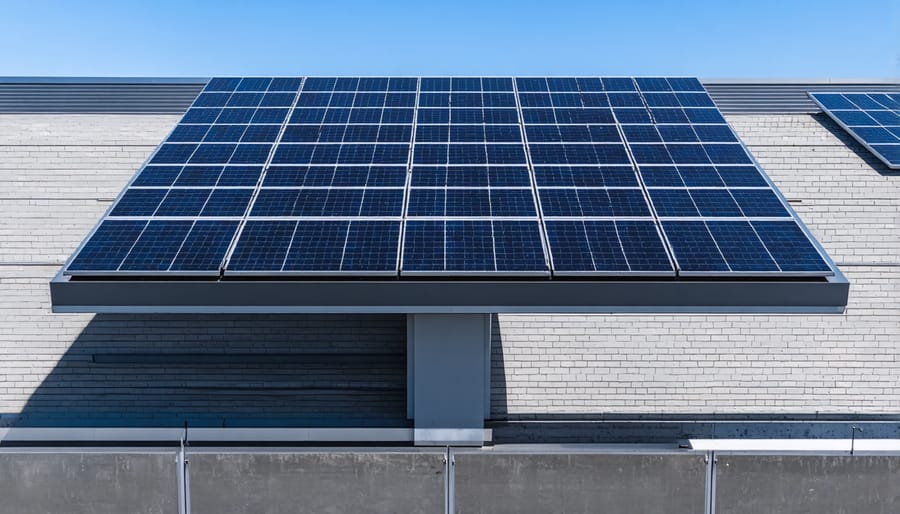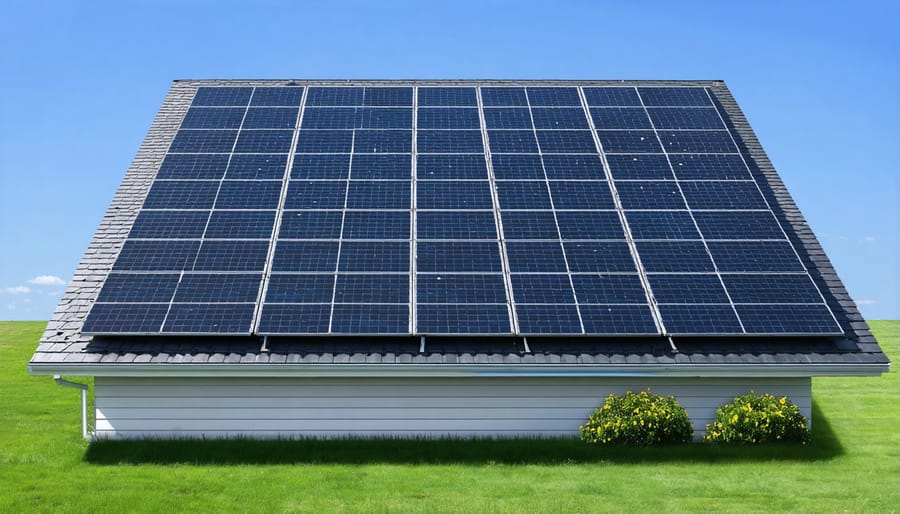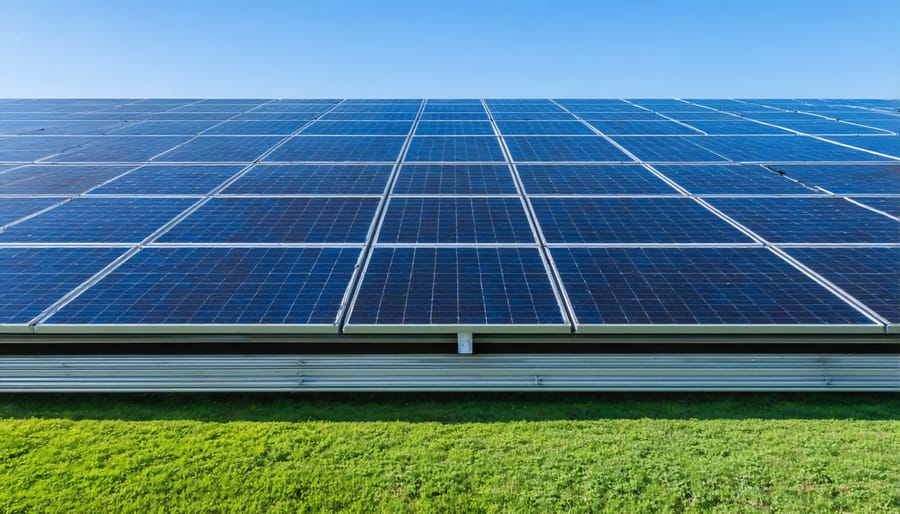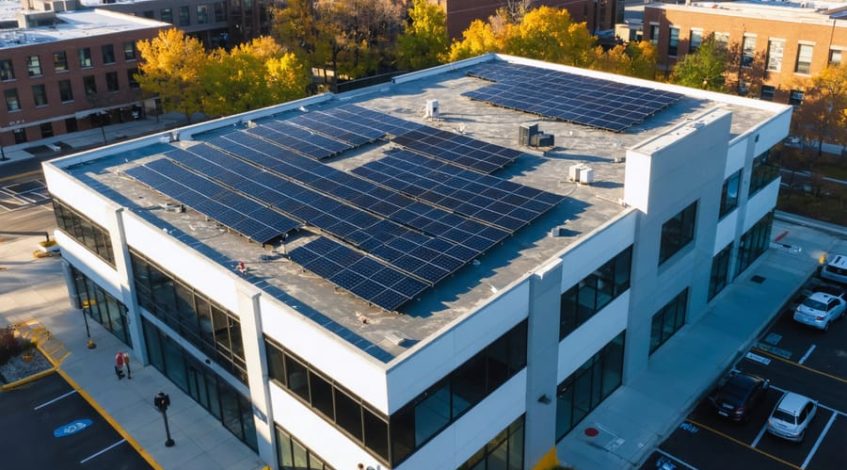Commercial solar installations deliver measurable property value increases of 3-4% on average, translating to substantial asset appreciation for building owners and real estate portfolios. This premium stems from quantifiable operational cost reductions, enhanced building certifications like LEED and BREEAM, and growing tenant demand for sustainable workspace—factors that sophisticated investors and property managers increasingly leverage for competitive advantage.
The commercial solar industry has matured beyond simple energy generation into a strategic financial instrument. Modern installations generate typical ROI within 4-7 years through combined energy savings, tax incentives, and accelerated depreciation benefits, while simultaneously extending beyond 25-year operational lifespans. Advanced monitoring systems now provide real-time performance data that property managers use to demonstrate value to stakeholders and attract premium tenants prioritizing environmental credentials.
Industry-specific applications reveal diverse implementation strategies: manufacturing facilities reduce peak demand charges through optimized solar-plus-storage configurations, while retail centers leverage visible installations as brand differentiation tools. Office buildings achieve net-zero energy certification, commanding higher lease rates and lower vacancy periods. Agricultural operations pair solar canopies with continued land productivity, maximizing revenue per acre.
Property valuation models increasingly incorporate energy cost predictability as a risk mitigation factor, with solar-equipped buildings demonstrating enhanced resilience during utility rate volatility. Forward-thinking property stakeholders recognize commercial solar not merely as an operational upgrade, but as a deliberate value-engineering strategy that strengthens balance sheets while meeting corporate sustainability mandates and regulatory requirements across evolving market conditions.
The Financial Impact of Solar on Commercial Property Valuation

Quantifying the Value Addition
Commercial solar installations deliver measurable financial benefits that extend well beyond monthly utility savings. Recent market analyses demonstrate that properties equipped with solar energy systems command premium valuations in today’s real estate market.
According to Lawrence Berkeley National Laboratory’s comprehensive study of commercial properties, solar installations increase property values by an average of $4 per installed watt. For a typical 500kW commercial system, this translates to approximately $2 million in added property value. Furthermore, the National Renewable Energy Laboratory reports that commercial solar arrays improve capitalization rates by 10-20 basis points, making these properties more attractive to institutional investors and lenders.
The impact on Net Operating Income (NOI) proves equally compelling. Commercial properties with solar installations typically experience NOI improvements of 15-25% due to reduced operating expenses. This enhancement directly influences property valuations, as commercial real estate values are calculated using the income capitalization approach. With energy costs representing 20-30% of operating expenses for most commercial facilities, the reduction in utility expenses flows directly to the bottom line.
Property appraisers increasingly recognize solar installations as permanent improvements rather than equipment, particularly when systems are roof-mounted or ground-mounted on owned land. This classification ensures that the value addition persists across ownership transitions. A 2023 study by the Appraisal Institute found that 78% of commercial appraisers now incorporate solar energy systems into their valuation calculations, up from just 34% in 2018.
Green building certifications, often achieved through solar installations, further amplify property values. LEED-certified commercial buildings with solar components command rent premiums of 5-7% and experience vacancy rates 4% lower than comparable non-certified properties, according to CBRE research data.
ROI Beyond Energy Savings
Commercial solar installations deliver substantial returns that extend well beyond monthly utility bill reductions. Understanding these additional financial advantages is crucial for making informed investment decisions and maximizing long-term profitability.
**Tax Incentives and Depreciation Benefits**
The Modified Accelerated Cost Recovery System (MACRS) allows businesses to depreciate solar installations over five years, significantly reducing taxable income. Combined with the Investment Tax Credit (ITC), which currently offers considerable federal tax benefits, the effective cost of solar infrastructure decreases substantially. State and local incentives often provide additional rebates or tax credits, varying by jurisdiction. These combined benefits can reduce initial capital requirements by 30-50%, making solar financing options increasingly attractive for businesses of all sizes.
**Enhanced Property Marketability**
Solar-equipped commercial properties demonstrate higher tenant retention rates and attract premium tenants seeking sustainable operations. A recent study of commercial office buildings found that LEED-certified properties with solar installations commanded rental premiums of 4-8% above comparable non-certified buildings. This advantage stems from corporate sustainability mandates and growing tenant demand for environmentally responsible spaces.
**Asset Value Appreciation**
Independent appraisals consistently show that commercial solar installations increase property values, with studies indicating appreciation ranging from $15,000 to $35,000 per installed kilowatt. This capitalization rate reflects both the immediate cash flow improvements and long-term energy cost predictability that solar provides.
**Hedging Against Energy Volatility**
Solar installations provide protection against utility rate fluctuations, which historically increase 3-5% annually. This price certainty enables more accurate long-term financial forecasting and budgeting, reducing operational risk and improving business planning capabilities. For multi-tenant properties, fixed energy costs become a competitive differentiator when negotiating leases.
Key Solar Innovations Driving Property Value Enhancement
High-Efficiency Photovoltaic Systems
Modern photovoltaic systems have achieved remarkable efficiency gains, fundamentally changing how businesses approach commercial solar installations. Today’s premium solar panels consistently deliver efficiency ratings between 20-22%, with some cutting-edge solar technologies reaching 23% and beyond. This advancement translates directly into measurable benefits for property owners seeking to maximize their investment returns.
Higher efficiency ratings mean businesses can generate more power from smaller roof areas, addressing one of the most common constraints in commercial installations. A facility that previously required 1,000 square meters of panels can now achieve the same output using approximately 800 square meters with high-efficiency modules. This space optimization proves particularly valuable for properties with limited roof access or those wanting to preserve areas for future expansion.
Modern panels also feature sleek, low-profile designs with all-black aesthetics that enhance rather than detract from building appearance. This design evolution has eliminated concerns about visual impact, making solar installations attractive additions to commercial properties. For businesses in retail, hospitality, or professional services, the improved aesthetics support brand image while demonstrating environmental commitment.
The combination of superior efficiency and refined design delivers concrete value through reduced installation costs, lower structural requirements, and enhanced curb appeal—factors that property appraisers increasingly recognize when evaluating commercial real estate assets equipped with modern photovoltaic systems.

Smart Monitoring and Energy Management Systems
Modern commercial solar installations deliver far more than electricity generation—they provide comprehensive visibility into system performance and energy consumption patterns. Real-time monitoring platforms have become essential components of commercial solar systems, enabling facility managers to track power production, identify inefficiencies, and maximize return on investment through data-driven decision-making.
Advanced monitoring systems continuously collect performance data from individual solar panels, inverters, and battery storage units, transmitting this information to cloud-based dashboards accessible from any device. This operational transparency allows businesses to verify that their systems are performing at expected levels and quickly identify when maintenance is required. Rather than waiting for noticeable production drops, predictive maintenance algorithms analyze performance trends to flag potential issues before they impact output, reducing downtime and extending equipment lifespan.
Energy management platforms integrate solar production data with building consumption patterns to optimize energy usage throughout the day. These systems can automatically adjust HVAC settings, shift non-critical operations to peak solar production hours, and intelligently manage battery charging cycles to maximize self-consumption and minimize grid dependence. For businesses with multiple facilities, centralized dashboards provide portfolio-wide visibility, enabling comparison of system performance across locations.
The financial impact proves substantial: facilities utilizing comprehensive monitoring and energy management systems typically achieve 5-15% higher energy cost savings compared to those without such platforms. This enhanced performance directly contributes to property value, demonstrating sophisticated operational capabilities and reducing long-term energy costs for potential buyers or tenants.
Integrated Battery Storage Solutions
Battery storage systems have emerged as a critical component in maximizing the value proposition of commercial solar installations. By pairing photovoltaic arrays with energy storage solutions, businesses can capture excess solar generation during peak production hours and deploy it strategically when electricity rates are highest or grid supply is constrained.
This integration delivers three distinct advantages for commercial properties. First, enhanced resilience through backup power capability ensures business continuity during grid outages—a particularly valuable asset for facilities where downtime translates to significant revenue loss. Second, grid independence reduces exposure to volatile electricity pricing and demand charges, with some enterprises achieving 70-80% energy autonomy. Third, battery storage increases market competitiveness by enabling participation in demand response programs and grid services that generate additional revenue streams.
Recent implementations demonstrate measurable returns. A Brisbane logistics center combined a 250kW solar array with 500kWh of battery storage, reducing peak demand charges by 65% and achieving payback within 6.8 years. Similarly, a Melbourne manufacturing facility leveraged storage to shift energy consumption patterns, cutting annual electricity costs by $180,000.
Modern battery management systems optimize charge-discharge cycles based on real-time pricing signals, weather forecasts, and operational requirements. This intelligent automation maximizes financial performance while extending battery lifespan, making integrated solar-plus-storage installations increasingly attractive to property investors focused on long-term asset appreciation.
Industry-Specific Applications and Case Studies
Manufacturing and Industrial Facilities
A leading automotive parts manufacturer in the Midwest demonstrates the transformative impact of commercial solar implementation on industrial operations. The 450,000-square-foot facility installed a 2.8 MW rooftop solar array, reducing annual electricity costs by $420,000 while decreasing carbon emissions by 1,850 metric tons yearly.
The installation generated immediate financial benefits beyond energy savings. The facility’s property valuation increased by 18% within the first year, attributed to reduced operational expenses and enhanced sustainability credentials. Third-party appraisers noted the predictable energy costs and 25-year warranty period as significant factors in the valuation increase.
Manufacturing facilities benefit uniquely from solar installations due to consistent daytime energy consumption patterns that align with peak solar production. This synchronization maximizes self-consumption rates, often exceeding 85%, and minimizes reliance on grid power during expensive peak-demand periods.
The facility’s sustainability certification opened new business opportunities with environmentally conscious clients, contributing to a 12% increase in contract acquisitions. Additionally, the solar installation qualified for accelerated depreciation benefits and state-level renewable energy incentives, improving the overall return on investment to 6.2 years.
Industrial property owners increasingly recognize solar installations as strategic assets that deliver measurable financial returns while positioning facilities competitively in markets where sustainability credentials influence partnership decisions and regulatory compliance requirements.

Commercial Real Estate and Office Buildings
Commercial real estate developers and property managers are increasingly recognizing solar installations as a strategic differentiator in competitive markets. Multi-tenant office buildings equipped with rooftop solar arrays attract environmentally conscious businesses willing to pay premium lease rates for workspace aligned with their sustainability commitments. Properties with solar installations routinely achieve LEED, NABERS, or Green Star certifications, enhancing marketability and tenant retention.
A 15-story office building in Brisbane demonstrated this advantage by installing a 250kW solar system, reducing common area electricity costs by 40% while achieving a 5-star Green Star rating. Within six months, the property attracted three Fortune 500 tenants specifically seeking certified green buildings, commanding rental premiums 12-15% above comparable non-certified properties. The commercial solar ROI extended beyond energy savings—the building’s valuation increased by $2.8 million based on enhanced NOI projections.
Property managers report that solar-equipped buildings experience lower vacancy rates and faster lease-up periods. Prospective tenants increasingly request sustainability credentials during site evaluations, making solar installations a competitive necessity rather than optional amenity. This trend particularly influences Class A office spaces where corporate ESG requirements drive leasing decisions.
Government and Institutional Properties
Public sector organizations increasingly recognize solar energy as a strategic investment that delivers measurable financial returns while demonstrating environmental leadership. A compelling example comes from the San Diego Unified School District, which implemented a comprehensive 25.4 MW solar program across multiple facilities. The installation generates over 40 million kilowatt-hours annually, resulting in $7.6 million in annual energy cost savings. More importantly, the 20-year power purchase agreement locked in predictable energy rates, protecting the district’s budget from volatile utility costs and allowing those savings to be redirected toward educational programs.
Government facilities typically possess ideal conditions for solar implementation: substantial roof space, high daytime energy consumption, and long-term ownership horizons that maximize ROI. Federal buildings across the United States have achieved average payback periods of 8-12 years, with systems operating efficiently for 25-30 years beyond that threshold.
The community impact extends beyond financial metrics. Public sector solar installations serve as visible demonstrations of sustainability commitment, enhancing public trust and encouraging private sector adoption. Municipal buildings with solar arrays report increased constituent engagement in renewable energy discussions and higher participation in community solar programs. Additionally, these projects often create local employment opportunities during installation and maintenance phases, supporting economic development objectives while advancing energy independence goals that resonate with taxpayers and stakeholders alike.
Strategic Considerations for Maximum Value Creation

Timing Your Solar Investment
Strategic timing can significantly impact the financial returns of your commercial solar investment. Currently, federal Investment Tax Credits (ITC) remain at 30% through 2032, making this an optimal window for installation. However, state and local incentives vary considerably and may have funding caps or expiration dates that require immediate action.
Property development cycles also play a crucial role in timing decisions. Installing solar during construction or major renovations reduces installation costs and minimizes operational disruption. Conversely, properties nearing lease renewals can leverage solar installations as tenant retention tools or value-added features for attracting premium lessees.
Market conditions including equipment costs, interest rates, and electricity prices should factor into your timeline. Solar panel prices have stabilized after years of decline, while financing remains competitive. Rising utility rates strengthen your business case, as each rate increase improves your system’s payback period.
For businesses planning facility expansions, integrating solar early ensures adequate roof space and electrical infrastructure. Real-world applications demonstrate that companies timing installations before major utility rate adjustments achieved 15-20% better long-term ROI compared to those who delayed. Consulting with experienced providers helps identify your optimal investment window based on your specific circumstances and financial objectives.
Selecting the Right Installation Partner
Choosing the right installation partner is critical to maximizing your commercial solar investment and ensuring long-term performance. Accredited installers with proven track records bring essential expertise to system design, regulatory compliance, and optimal equipment placement. Look for partners certified by the Clean Energy Council and backed by comprehensive warranties that protect both workmanship and components.
Quality equipment forms the foundation of reliable energy generation. Premium solar panels, inverters, and mounting systems may carry higher upfront costs but deliver superior efficiency, durability, and longer operational lifespans. Your installation partner should offer transparent specifications and performance guarantees that align with your business objectives.
Comprehensive support services distinguish exceptional providers from basic installers. This includes detailed feasibility assessments, customized system design, ongoing monitoring, and proactive maintenance programs. A dependable partner will guide you through the entire transition to solar energy, from initial consultation through commissioning and beyond.
Post-installation support is equally vital. Real-time performance monitoring, prompt troubleshooting, and regular system optimization ensure your solar asset continues delivering maximum value. Partners offering 24/7 technical support and guaranteed response times provide peace of mind while protecting your return on investment.
Documentation and Certification Benefits
Comprehensive system documentation significantly enhances commercial property marketability by providing prospective buyers with transparent performance data and maintenance records. Properties with complete documentation—including installation specifications, equipment warranties, and historical energy production reports—command premium valuations as buyers can accurately assess long-term returns. Extended manufacturer warranties, typically spanning 25 years for panels and 10-15 years for inverters, transfer to new owners and represent substantial value.
Green building certifications such as LEED, BREEAM, and ENERGY STAR further differentiate commercial properties in competitive markets. Solar installations contribute multiple points toward these prestigious certifications, attracting environmentally-conscious tenants willing to pay premium lease rates. A 2022 analysis found LEED-certified buildings achieved 7-18% higher rental income compared to non-certified counterparts. Proper certification documentation also facilitates streamlined refinancing and reduces insurance premiums, creating multiple financial advantages that directly translate into enhanced property values and faster transaction times.
The strategic advantages of commercial solar investments extend far beyond monthly utility savings. Property owners who integrate solar energy systems position themselves at the intersection of immediate operational efficiency and substantial long-term asset appreciation. The data consistently demonstrates that commercial properties with solar installations command premium valuations, attract quality tenants more readily, and demonstrate resilience against volatile energy markets.
Forward-thinking facility managers and business owners recognize that solar adoption represents a decisive competitive advantage in today’s sustainability-focused marketplace. The combination of reduced operating expenses, enhanced property marketability, accelerated depreciation benefits, and measurable environmental impact creates a compelling value proposition that strengthens with each passing year.
Now is the time to evaluate your commercial property’s solar potential. Conduct a comprehensive assessment of your facility’s energy consumption patterns, roof conditions, and available incentives. Engage with experienced solar providers who understand the technical requirements and financial structures that optimize return on investment. The commercial solar industry has matured to offer proven technologies, streamlined installation processes, and performance guarantees that minimize risk while maximizing value creation. Your property’s transformation into a high-performing, future-ready asset begins with that first strategic evaluation.

